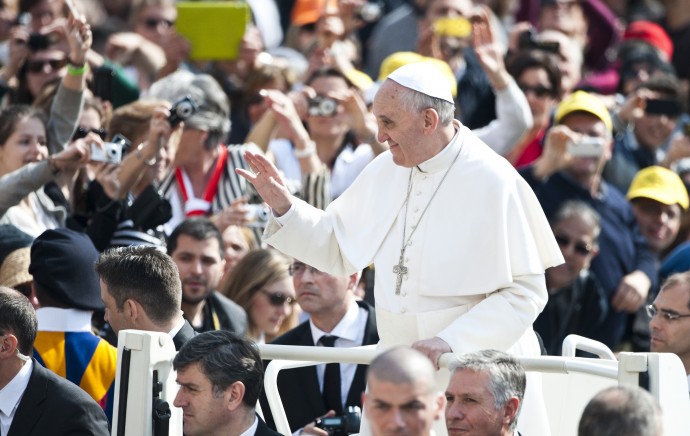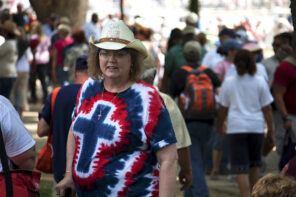While LGBT evangelicals cheered on the SCOTUS decision on gay marriage, evangelical institutions lobbied for the passage of “religious freedom” laws that would allow them to discriminate.
When President Obama mouthed platitudes during the funeral of the slain Rev. Clementa Pinckney at Emanuel AME, activist Bree Newsome took it upon herself to scale a flagpole and take down an instrument of hate and bigotry.
Pope Francis is a rock star, but Americans are still leaving church in droves.
This and other powerful juxtapositions are just part of the reason many of us now refer to American “Christianities,” rather than the singular “Christianity.” The five key stories below evoke questions that religion-watchers will be asking for years to come.
1. The Emptying of Church Pews
The trend that has received a significant amount of attention, from religious observers as well as religious leaders, is the so-called “Rise of the Religious Nones.” The number of dropouts/defectors from church involvement has risen significantly over the last several years, such that about 23 percent of the American population now claims no religious affiliation. They leave for many reasons, ranging from a general disillusionment with large-scale institutions in general to the politicization of religion and religious scandals—whether financial, sexual or both.
Beyond the general distrust of large-scale institutions and the disconnect between politics, culture and what people are looking for in church, this shift represents a failure on the part of most churches to provide a message and organizational structure that will both attract and retain church members. This will likely continue, but will churches adapt by figuring out what people want in church, or will they continue to stagnate and decline? On the other hand, what alternative forms, if any, of “church” might people be forming to replace the religious communities that they have left?

2. Increased LGBT Acceptance Within Evangelicalism
Although issues related to LGBT identities have long been a part of Mainline Protestant denominations such that LGBT individuals are largely accepted as just another member of the church, evangelicals have taken a much more adversarial stance to LGBT acceptance. However, increasing numbers of evangelical churches are accepting LGBT individuals as members.
This development is not without its opponents, however. Many evangelical organizations—most significantly colleges, universities and seminaries—are mobilizing to retain their “religious right” to discriminate against LGBT individuals. More than 30 evangelical higher education institutions have petitioned the U.S. Department of Education to receive a religious exemption from Title IX requirements related to sexual orientation and transgender identity.
What bears watching is not only what will happen among those evangelical organizations that are trying to hold back the march of history, but what will happen internally to evangelicalism itself. Increasing numbers of evangelical believers are either supportive of LGBT rights or at least not staunchly against it, while institutions that are part the “evangelical industrial complex” (churches, schools, publishing houses, etc.), have the resources and desire to maintain their anti-LGBT stance.
And this is not limited to white evangelicalism. The tension between the Black Lives Matter movement and some Black Church leaders is at least in part because of the legitimacy that BLM accords LGBT activists, who in turn are challenging traditional Church leaders as legitimate representatives of the African American community.
Will new cleavages appear within evangelicalism (or deepen within the Black Church), pitting these factions against each other? Or, will those groups that are not invested in either the evangelical industrial complex, or remaining culture war issues like LGBT rights, move to create alternative institutions that better serve their needs?
3. The Francis Effect
If Pope Francis’ fall 2015 tour is any indicator, he is having an enormous influence on the religious imagination of Catholics, other Christians, and even those of other (and no) faith. His (seemingly) more open and welcoming take on Catholicism, his embrace of anybody who approaches him, and his frankly fearless presentation of a much more friendly Catholicism, has many Catholics hoping for a “Francis effect” that will draw Catholic church dropouts back, or even attract new converts.
I have my doubts that a newly resurgent Catholic Church will result from the Pope’s influence. There is just too much institutional inertia in how the Church is organized and a charismatic Pope, however inspiring his message may be, is unlikely to change that.
Will there be a larger “Francis effect” that results in bringing religion into the public conversation about social justice? Or will this just be a lot of media hoopla with no real, practical effects developing from his influences?
4. The Localization of Church
Smaller, local-oriented churches seem to be popping up all over the place, each with a general emphasis on being an active part of their local communities. Although these tend to mostly be evangelical churches, there are some more experimental Mainline Protestant congregations in the mix. They appeal to an increasing desire among many Christians to be in smaller, more intimate communities and to be an active member in the neighborhoods where they are located. These churches tend to think of themselves as a family environment that is as much focused on its surrounding neighborhoods as it is on its own members.
Even megachurches are getting in on the act by establishing franchised outposts in different local communities that are somewhat remote from the mother church. The difference between the megachurch franchise locations and the more independent congregations generally tends to be in terms of resourcing (the mega franchises have more) and content (mega franchise churches tend to deliver the same product as the home church). However, the presence of smaller, remotely located mega franchises indicates that the “church in the local community” is now an important development within Christianity. This can really be thought of as a type of parish model, although the independence of most of these churches (as compared to the Catholic model) sets them apart.
How long will this trend continue, and in what ways will it develop over the coming years? One of the drivers of this effort is related to the desires of younger Christians to live and work in urban areas. But with the influx of mostly younger and white members, what happens to the city, and the Christian voice that remains?
5. Urban Ministry Goes Mainstream
There is a long history of urban churches and ministries in the U.S.—whether Mainline, Catholic or evangelical—whose avowed purpose is to minister to the urban poor and dispossessed. Of course, there is also a history of churches vacating urban spaces when their neighborhoods became less like their membership. But in many ways the presence of urban ministries has served as a sort of corrective (or at least collective guilt reliever) for suburban churches.
Over the last 15 years or so, there has been a resurgence of churches and other ministries being established in tough urban neighborhoods, while some never left. The Los Angeles Dream Center is a good example of the former, while the Union Rescue Mission is an example of the latter.
This resurgence correlates with the current urban revitalization efforts in many cities. As urban areas are redeveloped, mostly younger professionals have moved into the newly built condos and lofts to take up residence in what were formerly “sketchy” areas. The result is that those neighborhoods have now gentrified, with new residents, restaurants, shops and the like, requiring rents that the former residents cannot afford. The result is that many of the newer urban churches—and some of those that have a longer history in a particular city—are now congregations of mostly young creative types who live in the vicinity.
What will happen when urban hipster churches, like Hillsong, Oasis and RealityLA, come into contact with other churches and urban ministries? (Indeed, do they ever come into contact or do they each maintain their own spheres of involvement?) And what will become of the Christian urban presence as neighborhoods gentrify and different churches and ministries are priced out?





